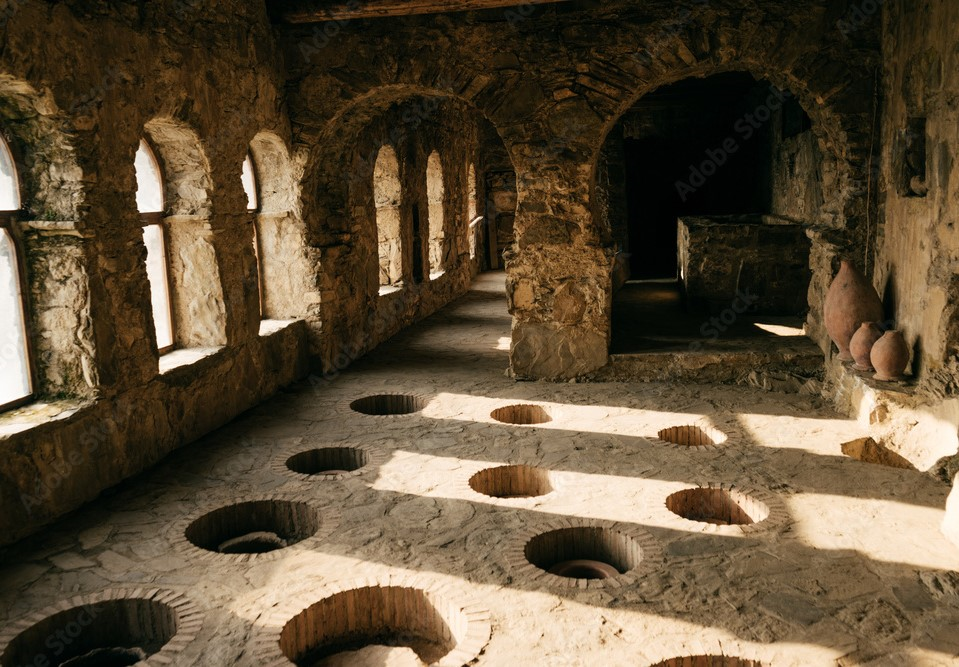- Wine Color/Type
- Top Occasions
- Unique Wines
- Surprise Me!
Introduction to Amphora-aged Wine
You may have noticed "Amphora aged" on some wine labels. The amphora, a vessel made of terracotta clay with centuries of history in wine production, is making a comeback in modern winemaking. Amphora-aged wines have a rich history and heritage, and they are becoming more and more well-liked among winemakers and consumers in the modern wine scene.
Ancient Georgia used Qvevri for winemaking buried in the ground (Photo: nelen.rustock/adobe.com)
History of Amphora
Amphorae have a long history dating back thousands of years to the ancient civilizations of Greece and Rome. The term "amphora" is derived from the Greek word "amphiphoreus," which means "something that can be carried from both sides." These clay pots were used to store and transport a variety of products, including wine. The use of amphorae in winemaking can be traced back to Georgia about 6,000 to 8,000 years ago, which is believed to be the birthplace of wine.
Over time, a variety of amphorae have evolved, each with its own special historical importance. Some notable examples are the ancient Roman Dolium, the Qvevri from Georgia, and the Spanish traditional vessel Tinaja. Amphorae differ in size, shape, and material, but they are all constructed of clay, which creates a porous atmosphere that reacts differently with the wine.
Amphora Aged Wine
Amphora is a porous and inert vessel, which sets it apart from stainless tanks or wooden barrels (most commonly, oak barrels). The former is a neutral container but does not allow the exchange of oxygen while the latter imparts distinctive aromas and flavors to wine, as well as the wooden tannins. Clay amphorae allows a slow and subtle aging process with a moderate oxygen exchange procedure without adding extra flavors to the wine. Amphorae can now range in size from 320 to 1600 liters, giving winemakers more options in their work.
Wines matured in amphorae have a more concentrated focus on the terroir and purity of fruit expression. Because of this, the wine is a true representation of the grape variety and the distinctive qualities of the terroir, appealing to those who want a real sense of place.
Amphora Aged vs. Oak Aged
The choice between aging wine in amphora or oak barrels significantly shapes the final product. Oak aging, a well-established practice, gives wine unique aromas and textures that are impacted by the tannins in the wood. Amphora-aged wines, on the other hand, do not have oak flavours, drawing attention to the inherent characteristics of the grape and the terroir. A wine that is more faithful to its origins and frequently described as true to its origins.
Why are Amphorae Getting Popular?
The increase in interest in amphora-aged wines corresponds to current wine trends a desire for authenticity and minimal intervention in winemaking. Amphora offers a middle ground between the porous oak barrels and the hermetically sealed stainless steel tanks.
Consumer preferences are shifting. In today’s wine scene, wine enthusiasts are no longer looking for oaky, homogenous-styled wines. Instead, elegant, delicate, more authentic, and sometimes natural wines are gaining popularity. In this regard, amphora stands out as a container that meets this need and upholds the principles of "low intervention, terroir-driven wine." A rising number of discerning consumers who value the artistry involved in creating wines with a true connection to the land are drawn to Amphora-aged wines.
Additionally, from the wine production perspective, the economic aspect cannot be overlooked. Oak barrels, a traditional winemaking mainstay, are not only expensive but also have a relatively short lifespan of 3 to 5 years. Amphorae, on the other hand, are a one-time investment that lasts indefinitely, providing a cost-effective and sustainable alternative for the winemaking process. The ease of cleaning and maintenance further adds to the appeal, providing winemakers with a practical option that promotes both environmental and economic sustainability.
Amphora-aged Wines in the World
Georgia, often referred to as the cradle of wine, has a deep-rooted tradition of using large clay vessels known as qvevris for winemaking. UNESCO recognizes the practice of fermenting and aging wine in buried Qvevris as part of the intangible cultural heritage of humanity. Georgian qvevri wines are celebrated for their unique profiles, showcasing ancient winemaking techniques passed down through generations.
Amphora-aged wines are creating a niche in old-world countries such as France and Italy, first adopted by famous natural winemakers such as COS, Gravner, and Foradori. Spain contributes to the global amphora-aged wine movement with its traditional vessel, the Tinaja.
Beyond the old-world traditions, new-world countries are increasingly adopting and exploring amphora aging for red and white wines. The allure of this ancient method is spreading across diverse wine-producing regions, as winemakers seek to capture the authenticity and unique expressions offered by clay vessels.
Amphora-aged Wines to Try:
COS Pithos Rosso
The pioneer of amphora-aged wine in Sicily, 100% Nero d’Avola, the iconic red wine of the Mediterranean island.
[insert:wine:cos-pithos-rosso-2021]
Clos Canarelli Corse Figari Amphora Rouge
The unique terroir and indigenous varieties of Corsica, combined with amphora aging.
[insert:wine:clos-canarelli-amphora-corse-figari-2021]
Latest articles

